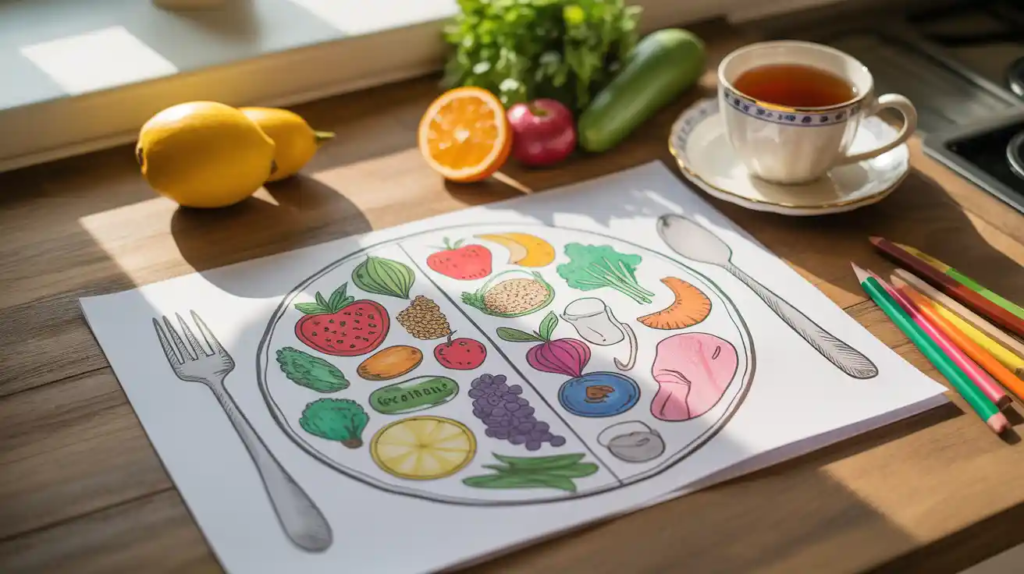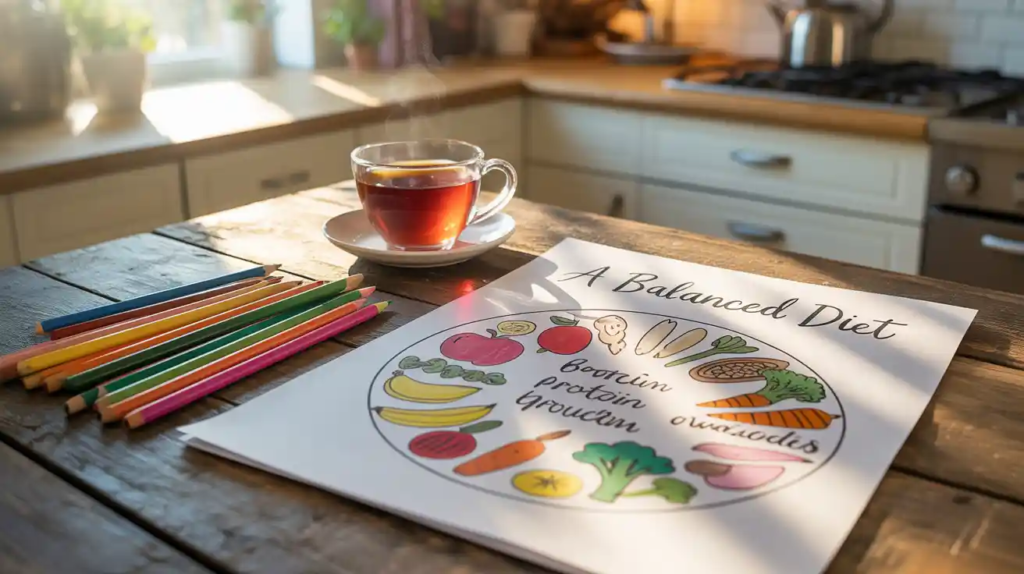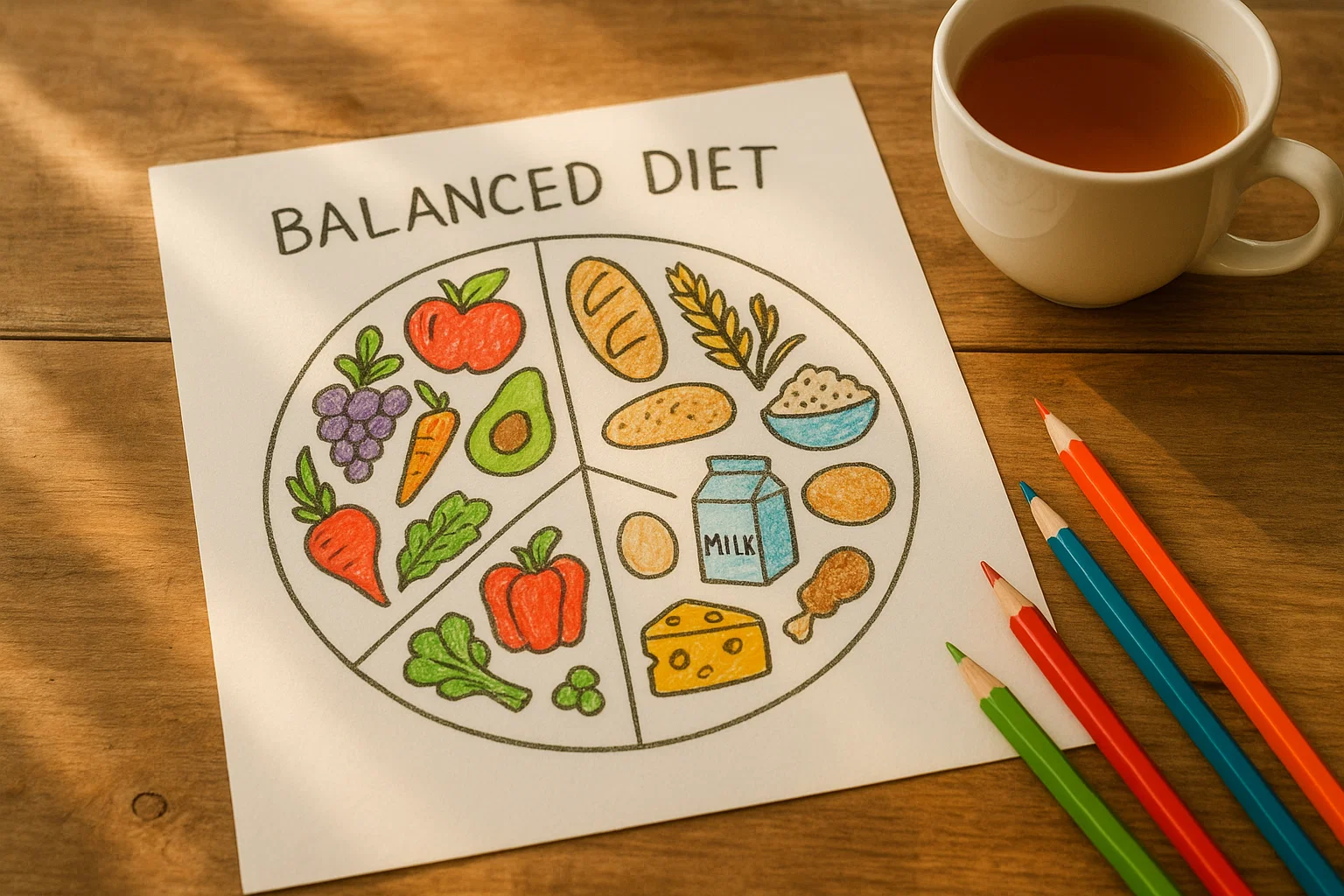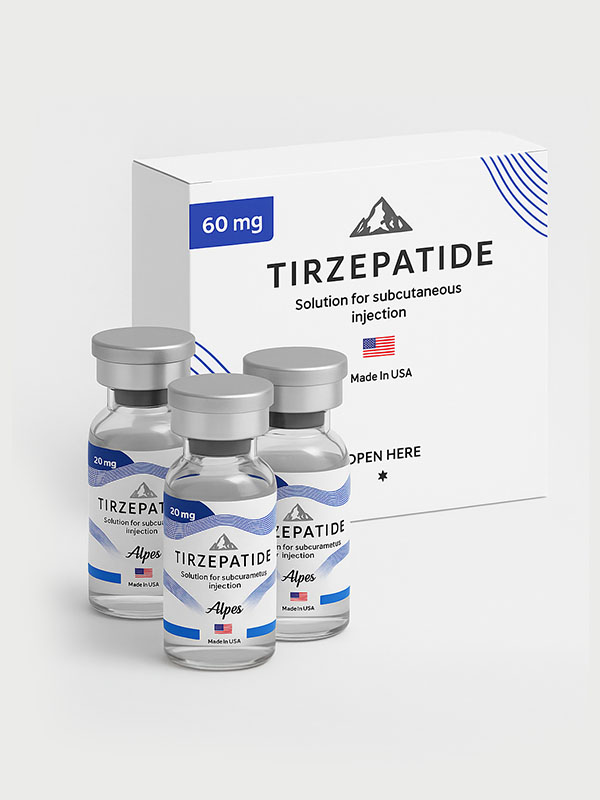Meta Title:
Balanced Diet Chart Drawing – Fun, Simple, and Healthy Eating Made Visual
Meta Description:
Discover how to create a balanced diet chart drawing that’s colorful, practical, and inspired by real life. Learn easy steps, common mistakes to avoid, and why this visual guide can transform your eating habits.
You know those moments when you’re scrolling online, and suddenly you fall down a rabbit hole of weirdly satisfying content?
For me, it was a series of hand-drawn balanced diet charts. Yes, actual charts — with fruits, veggies, grains, and little doodles of eggs wearing sunglasses.

I’m not exaggerating when I say: I spent an entire Sunday afternoon with a pen, some colors, and a cup of chai… sketching my own balanced diet chart drawing.
And here’s the thing — it wasn’t just some Pinterest-inspired art project. It actually made me eat better.
I realized this wasn’t just about drawing a cute chart. It was about making my food choices… visual. Tangible. Almost like a friendly guilt-trip on paper.
So let’s talk about why you should absolutely make your own balanced diet chart drawing (and how to do it without turning it into a boring school project).
My Accidental Love Story with a Balanced Diet Chart
Here’s the backstory.
A few months ago, I noticed my lunch was basically a beige buffet. Bread, cheese, coffee, maybe a cookie. If my diet were a movie, it would’ve been rated PG — Pretty Grim.
Then, one day, I visited a friend’s place, and there on her fridge was this hand-drawn, colorful balanced diet chart.
It wasn’t perfect — in fact, the bananas looked suspiciously like boomerangs — but it was so inviting. You could literally see the food groups: fruits, vegetables, proteins, grains, dairy.
Something clicked.
If I could see what my ideal meals looked like every day, maybe my plate would stop being a carb-only crime scene.
Fun Fact: Balanced Diet Charts Aren’t Just for Kids
When I first googled “balanced diet chart drawing,” all I saw were school projects. Colorful plates divided into wedges, cartoon apples, happy milk cartons.
And yes, they’re great for teaching kids. But… why did we, as adults, just stop doing this?
We’ll spend hours making aesthetic Notion boards for work goals, but when it comes to what we put in our bodies every single day, we rely on vague mental notes like “eat healthier.”
A balanced diet chart drawing is basically a visual contract between you and your health. And honestly, your brain loves visuals way more than a boring text list.
The Simple Science Behind It
Without turning this into a health lecture, here’s the gist:
A balanced diet means getting the right mix of carbohydrates, proteins, fats, vitamins, and minerals — in the right proportions.
When you draw it, you’re essentially telling your brain:
- Half my plate = fruits and veggies
- One-quarter = proteins
- One-quarter = grains
- Plus a small portion of healthy fats and dairy
And suddenly, you have this little map for your meals that’s easier to follow than most diets you’ve ever tried.
How to Make Your Own Balanced Diet Chart Drawing (Even If You Can’t Draw)
You do not need to be an artist. (My chicken drumsticks still look like sad balloons.) Here’s my foolproof way to do it:
Step 1: Grab Your Supplies
You need:
- A blank A4 sheet (or a page in your notebook)
- Black pen or marker
- Color pencils/markers (because color = fun)
Step 2: Divide the Plate
Draw a big circle. Split it into sections:
- 50% for fruits and veggies
- 25% for proteins
- 25% for grains
Add a small corner for fats/dairy if you want extra detail.
Step 3: Add Doodles
Don’t just write “protein” — draw a fish, an egg, a bean.
Fruits? Sketch an apple or a mango. Grains? Tiny rice grains or bread slices.
Step 4: Make It Personal
Hate broccoli? Don’t draw it. Love sweet potatoes? Give them extra space.
The point is to make it reflect your ideal diet, not a generic “health book” version.
Step 5: Put It Somewhere You’ll See It
Mine’s on the fridge. My friend has hers as her phone wallpaper.
Visual cues = better daily choices.
The “Secret” Benefit Nobody Talks About
Okay, here’s what surprised me.
Making a balanced diet chart drawing doesn’t just make you eat better — it actually makes you want to eat better.
Why? Because you’ve invested time into it. You’ve made this little piece of art, and now you want to honor it.
It’s the same feeling you get when you buy a fancy planner and suddenly really want to stick to your to-do list.
Common Mistakes People Make with Balanced Diet Chart

I’ve seen a lot of versions online, and here’s where they go wrong:
1. Making It Too Complicated
If your chart looks like an Excel sheet exploded on it, you won’t follow it. Keep it simple.
2. Forgetting Snacks
Snacks happen. Include a small section for healthy ones, so you’re not caught unprepared at 4 PM.
3. Ignoring Cultural Foods
If your diet includes chapati, dal, or kimchi, put them in. Don’t copy some Western chart that ignores your actual lifestyle.
4. Not Updating It
Your food preferences change. So should your chart.
Pros & Cons of Drawing Your Diet
Pros:
- Visually satisfying
- Easy to follow
- Great fridge art
- Kids love it (bonus if you’re a parent)
Cons:
- Initial time investment (but honestly, it’s fun)
- If you ignore it, it’s just… pretty paper
- People might tease you for having “kindergarten art” in your kitchen (wear it as a badge of honor)
My Slightly Bold Opinion: Every Doctor’s Office Should Have These
I’m serious. Imagine sitting in a waiting room and instead of staring at faded anatomy posters, you’re looking at colorful, inviting balanced diet charts.
They’d stick in people’s minds way more than pamphlets with tiny text.
And if you’re a parent? Drawing one with your kid could be one of the sneakiest ways to get them to actually eat vegetables.
Trendy Twist: Digital Balanced Diet Chart Drawings
If you’re more of a tablet-and-stylus person, you can do this digitally. Apps like Canva, Procreate, or even Google Drawings can make it easy.
But here’s my warning — digital charts don’t have the same “I-made-this-with-my-own-hands” magic. They’re neat, sure, but the tactile feeling of drawing one is part of why it works.
Final Thoughts: Why You Should Try This (Like, Today)
Making a balanced diet chart drawing is a small, fun project that pays off in big ways.
You get a clearer idea of what you should eat, you make healthier choices without obsessing over calories, and you get a little daily art therapy in the process.
So here’s my challenge:
Tonight, grab a pen, make your own version, stick it on your fridge, and actually follow it for a week.
Then come back and tell me — did your plate look different? Did you snack smarter? Did you… draw sunglasses on your banana?


